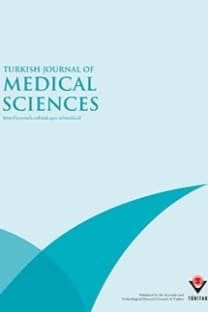Risk factors for acquisition of methicillin-resistant Staphylococcus aureus and clonal spread of the isolates in a medical intensive care unit
Aim: Methicillin-resistant Staphylococcus aureus (MRSA) is still the commonest pathogen in hospital-acquired infections with high morbidity and mortality. MRSA colonization usually precedes infection and dissemination of the microorganism. The aim of this study was to determine risk factors for the colonization and infection with MRSA in a medical intensive care unit (MICU) and to show the genetic relation of strains. Materials and methods: This study was conducted prospectively between 1 December 2004 and 31 January 2006 in MICU. Patients (>16 years) admitted to the MICU were screened for MRSA on admission (in the first 48 hours), at the end of the first week, and at the ICU discharge using anterior nares, axilla, and groin swabs. Risk factors for colonization and infection of MRSA were evaluated. Strains isolated from colonized patients were evaluated for genetic relation. Results: During the study period, 259 patients were evaluated for the risk factors of MRSA acquisition. The colonization rate was 18.5%, and 64.6% of the patients were colonized in the first week. In multiple logistic regression analysis, only the length of stay in MICU and mechanical ventilation were significant risk factors for colonization. MRSA infection occurred in 15 (31%) of 48 colonized patients during MICU stay. MRSA colonization and tracheostomy were significant risk factors for MRSA infection. A genetic relation was found in 48 isolates from colonized patients in MICU and 23 isolates from colonized patients on admission. Overall, 4 clones (clone A, B, C, and D) were determined from colonized patients on admission; clone A (37%), clone B (32%), clone C (21%), and clone D (10%). Moreover, patients colonized during MICU stay had similar clones (clone A-30%, clone B-57%, and clone C-13%) with these patients. Conclusion: This study shows a high colonization rate and dissemination of MRSA in a developing country with inadequate infrastructure (lack of nurse, lack of isolation rooms, and heavy workload).
Risk factors for acquisition of methicillin-resistant Staphylococcus aureus and clonal spread of the isolates in a medical intensive care unit
Aim: Methicillin-resistant Staphylococcus aureus (MRSA) is still the commonest pathogen in hospital-acquired infections with high morbidity and mortality. MRSA colonization usually precedes infection and dissemination of the microorganism. The aim of this study was to determine risk factors for the colonization and infection with MRSA in a medical intensive care unit (MICU) and to show the genetic relation of strains. Materials and methods: This study was conducted prospectively between 1 December 2004 and 31 January 2006 in MICU. Patients (>16 years) admitted to the MICU were screened for MRSA on admission (in the first 48 hours), at the end of the first week, and at the ICU discharge using anterior nares, axilla, and groin swabs. Risk factors for colonization and infection of MRSA were evaluated. Strains isolated from colonized patients were evaluated for genetic relation. Results: During the study period, 259 patients were evaluated for the risk factors of MRSA acquisition. The colonization rate was 18.5%, and 64.6% of the patients were colonized in the first week. In multiple logistic regression analysis, only the length of stay in MICU and mechanical ventilation were significant risk factors for colonization. MRSA infection occurred in 15 (31%) of 48 colonized patients during MICU stay. MRSA colonization and tracheostomy were significant risk factors for MRSA infection. A genetic relation was found in 48 isolates from colonized patients in MICU and 23 isolates from colonized patients on admission. Overall, 4 clones (clone A, B, C, and D) were determined from colonized patients on admission; clone A (37%), clone B (32%), clone C (21%), and clone D (10%). Moreover, patients colonized during MICU stay had similar clones (clone A-30%, clone B-57%, and clone C-13%) with these patients. Conclusion: This study shows a high colonization rate and dissemination of MRSA in a developing country with inadequate infrastructure (lack of nurse, lack of isolation rooms, and heavy workload).
